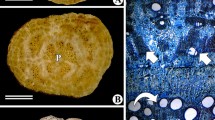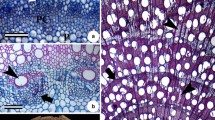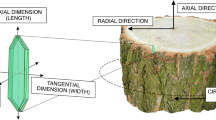Abstract
Stem diameter in Gallesia integrifolia (Spreng.) Harms (Phytolaccaceae) increases by forming concentric rings of xylem alternating with phloem, which show frequent anastomoses. After a period of primary growth and the formation of first (normal) ring of vascular cambium, further successive rings are initiated outside this cambium. The second ring of cambium originates from the pericycle parenchyma located between the proto-phloem, and the pericycle fibres. Each cambium produces centripetally secondary xylem and centrifugally secondary phloem. Differentiation of xylem precedes that of phloem and the first elements formed are always xylem fibres. Structurally, the vascular cylinder is composed by successive rings of secondary xylem and phloem. These rings are separated by wide bands of conjunctive parenchyma tissue. Presence of collateral vascular bundles with irregular orientation is observed in the region of anastomoses of two or more bands of conjunctive tissue. These bundles are surrounded by isodiametric, lignified and thick-walled cells. In some of the cambial rings, occurrence of polycentric rays was also noticed; these rays are tall, and characterized by the presence of meristematic regions that differentiated into thick-walled elements of secondary xylem. Origin and development of the successive cambia and the structure of xylem are discussed.



Similar content being viewed by others
References
Baird WV, Blackwell WH (1980) Secondary growth in the axis of Halogeton glomeratus (Bieb.) Meyer (Chenopodiaceae). Bot Gaz 141:269–276
Berlyn GP, Miksche JP (1976) Botanical microtechnique and cytochemistry. The Iowa State Univ. Press, Ames
Carlquist S (1999) Wood and stem anatomy of Stegnosperma (Caryophyllales); phylogenetic relationships; nature of lateral meristems and successive cambial activity. IAWA J 20:149–164
Carlquist S (2001) Comparative wood anatomy: systematic, ecological, and evolutionary aspects of dicotyledon wood. Springer, Berlin, p 448
Carlquist S (2004) Lateral meristem, successive cambia and their products: a reinterpretation based on roots and stems of Nyctaginaceae. Bot J Linn Soc 146:129–143
Carlquist S (2007a) Successive cambia revisited: ontogeny, histology, diversity, and functional significance. J Torrey Bot Soc 134:301–332
Carlquist S (2007b) Successive cambia in Aizoaceae: products and process. Bot J Linn Soc 154:141–155
Carvalho PER (2003) Espécies arbóreas brasileiras. Embrapa Informações Tecnológica, Colombo
Committee IAWA (1989) List of microscopic features for hardwood identification. IAWA Bull 10:219–332
DeMason DA (1983) The primary thickening meristem: definition and function in monocotyledons. Amer J Bot 70:995–962
Fisher JB, Ewers FW (1991) Structural responses to stem injury in vines. In: Putz FE, Mooney HA (eds) The biology of vines. Cambridge University Press, Cambridge, pp 99–124
Hernandez-Ledesma P, Terrazas T, Flores-Olvera H (2011) Comparative stem anatomy of Mirabilis (Nyctaginaceae). Plant Syst Evol 292:117–132
Horak K (1981) The three dimensional structure of vascular tissue in Stegnosperma (Phytolaccaceae). Bot Gaz 142:445–449
Isnard S, Silk WK (2009) Moving with climbing plants from Charles Darwin’s time into the 21st century. Amer J Bot 96:1205–1221
Kirchoff BK, Fahn A (1984) Initiation and structure of the secondary vascular system in Phytolacca dioica L. (Phytolaccaceae). Can J Bot 62:2580–2586
Kraus JE, Arduin M (1997) Manual básico de métodos em morfologia vegetal. Editora EDUR, Rio de Janeiro
Longui EL, Lima IL, Andrade IM, Freitas MLM, Florsheim SMB, Zanatto ACS, Silva FG Jr (2011) Seed provenance influences the wood structure of Gallesia integrifolia. IAWA J 32:361–374
Mainieri C, Chimelo JP (1989) Fichas de características das madeiras brasileiras. Instituto de Pesquisas Tecnológicas, São Paulo
Menezes NL, Silva DC, Arruda RCO, Melo de Pinna GF, Cardoso VA, Castro NM, Scatena VL, Scremindias E (2005) Meristematic activity of the endodermis and the pericycle in the primary thickening in monocotyledons. Considerations on the “PTM”. Anais da Academia Brasileira de Ciências 77:259–274
Mikesell JE (1979) Anomalous secondary thickening in Phytolacca americana L. (Phytoloccaceae). Amer J Bot 66:997–1005
Mikesell JE, Popham RA (1976) Ontogeny and correlative relationships of the primary thickening meristem in four-o’clock plants (Nyctaginaceae) maintained under long and short photoperiods. Amer J Bot 63:427–437
Patil VS, Marcati CR, Rajput KS (2011) Stem anatomy and development of intraxylary and interxylary secondary phloem in Coccinia indica L. (Cucurbitaceae). IAWA J 32:475–491
Paula JE, Alves JLH (2007) 897 Madeiras nativas do Brasil. Cinco Continentes, Porto Alegre
Philipson WR, Ward JM (1965) The ontogeny of vascular cambium in the stem of seed plants. Biol Rev 40:534–579
Rajput KS, Rao KS (1999) Structural and developmental studies on cambial variant in Pupalia lappacea (L) Juss. (Amaranthaceae). Ann Bot Fennici 36:137–141
Rajput KS, Patil VS, Kapadne KK (2009) Structure and development of secondary thickening meristem in Mirabilis jalapa (Nyctaginaceae). Pol Bot J 54:113–121
Rajput KS, Patil VS, Kapadane KK (2010) Development of lateral meristem and pattern of secondary growth in stem and roots of Spinacia oleraceae Linn. (Amaranthaceae). Feddes Repertorium 121:1–10
Robert EMR, Schmitz N, Boeren I, Driessens T, Herremans K, Mey JD, Casteel EV, Beeckman H, Koedam N (2011) Successive cambia: a developmental oddity or an adaptive structure? PLoS ONE 6:e16558. doi:10.1371/journal.pone.0016558
Roeser KR (1972) Die nadel der Schwarzkiefer-massenprodukt und kunstwerk der natur. Mikrokosmos 61:33–36
Spicer R, Groover A (2010) Evolution of development of vascular cambia and secondary growth. New Phytol 186:577–592
Stevenson DW, Popham RA (1973) Ontogeny of the primary thickening meristem in seedlings of Bougainvillea spectabilis. Amer J Bot 60:1–9
Studholme WP, Philipson WR (1966) A comparison of the cambium in two woods with included phloem: Heimerliodendron brunonianum and Avicenia resinifera. New Zeal J Bot 4:355–365
Tamaio N, Vieira RC, Angyalossy V (2009) Origin of successive cambia on stem in three species of Menispermaceae. Revista Brasil Bot 32:839–848
Terrazas T, Rodriguez SA, Ojanguren CT (2011) Development of successive cambia, cambial activity, and their relationship to physiological traits in Ipomoea arborescens (Convolvulaceae) seedlings. Amer J Bot 98:765–774
Wheat D (1977) Successive cambia in the stem of Phytolacca dioica. Amer J Bot 64:1209–1217
Yarrow GL, Popham RA (1981) The ontogeny of primary thickening meristem of Atriplex hortensis L. (Chenopodiaceae). Amer J Bot 86:1042–1049
Acknowledgments
Authors are thankful to both the anonymous reviewers and the editors for their valuable suggestions on the manuscript.
Author information
Authors and Affiliations
Corresponding author
Additional information
Communicated by E. Beck.
Rights and permissions
About this article
Cite this article
Rajput, K.S., Romeiro, D., Longui, E.L. et al. Development of successive cambia and structure of wood in Gallesia integrifolia (Spreng.) Harms (Phytolaccaceae). Trees 26, 1943–1950 (2012). https://doi.org/10.1007/s00468-012-0762-z
Received:
Revised:
Accepted:
Published:
Issue Date:
DOI: https://doi.org/10.1007/s00468-012-0762-z




